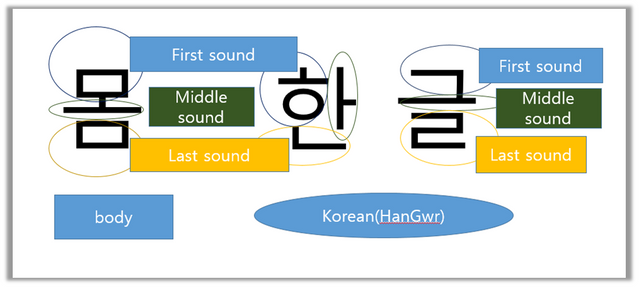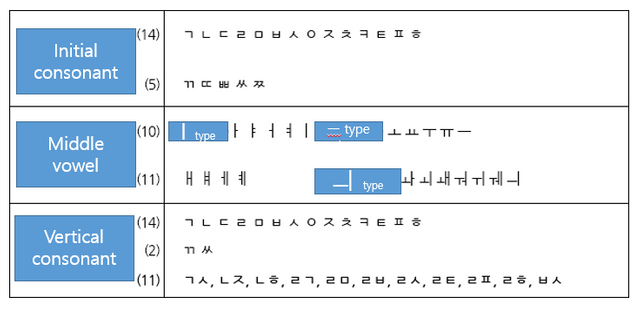How to Learn Korean - Application of Korean consonants and vowels – plus rules
Application of Korean consonants and vowels – plus rules
The basic alphabet of HanGwr is 14 consonants and 10 vowels.
[Currently used consonant 14 letters]
ㄱ ㄴ ㄷ ㄹ ㅁ ㅂ ㅅ ㅇ ㅈ ㅊ ㅋ ㅌ ㅍ ㅎ
[Currently used vowel 10 letters]
ㅏ ㅑ ㅓ ㅕ ㅗ ㅛ ㅜ ㅠ ㅡ ㅣ
However, the basic consonant is transformed into several different consonants with the rule of plus. Basic vowels are also transformed into various vowels with the rule of addition. So Korean(HanGwr) is the first language that can express the most sounds in the world.
In this article, we'll learn about the consonant and vowel variant strain.
The following is a variation consonant that uses two identical consonants to each other to give a stronger sound.
ㄱ plus ㄱ ==========> ㄲ
ㄷ plus ㄷ ==========> ㄸ
ㅂ plus ㅂ ==========> ㅃ
ㅅ plus ㅅ ==========> ㅆ
ㅈ plus ㅈ ==========> ㅉ
This is called a double consonant and is used to make a strong sound.
The first letters in HanGwr are 19 consonants.
ㄱ(g) ㄴ(n) ㄷ(d) ㄹ(r) ㅁ(m) ㅂ(b) ㅅ(s) ㅇ( or x) ㅈ(j)
ㅊ(ch) ㅋ(k) ㅌ(t) ㅍ(p) ㅎ(h)
ㄲ(gg) ㄸ(dd) ㅃ(bb) ㅆ(ss) ㅉ(jj)
Let's learn about a variation vowels.
ㅏ plus ㅣ ==========> ㅐ
ㅑ plus ㅣ ==========> ㅒ
ㅓ plus ㅣ ==========> ㅔ
ㅕ plus ㅣ ==========> ㅖ
ㅗ plus ㅏ ==========> ㅘ
ㅗ plus ㅣ ==========> ㅚ
ㅗ plus ㅐ ==========> ㅙ
ㅜ plus ㅓ ==========> ㅝ
ㅜ plus ㅣ ==========> ㅟ
ㅜ plus ㅓ ==========> ㅝ
ㅡ plus ㅣ ==========> ㅢ
This is the 10 basic vowels.
ㅏ(a) ㅑ(ya) ㅓ(e) ㅕ(ye) ㅗ(o) ㅛ(yo) ㅜ(u) ㅠ(yu) ㅡ(w) ㅣ(y)
And there are 11 letters of the plus strain vowel.
*ㅐ(ay) ㅒ(yay) ㅔ(ey) ㅖ(yey)
ㅘ(oa) ㅚ(oay) ㅙ(oay) ㅝ(ue) ㅟ(uy) ㅝ(ue) ㅢ(wy)
It is a representation of the HanGwr RoMang font in the variation vowel.
The 21 Korean vowels are used as the middle or last sound.
In the ‘마(ma)’ of the 마음(mind), the vowel ‘ㅏ(a)’ is the last sound.
For ‘음(xwm)’, ‘ㅡ (w)’ is the middle sound.
Again, the HanGwr vowel is used as the middle sound, sometimes the last sound.
Last sound, also called a prop. This is a bit more complicated.
But you do not feel too hard now, you just have to look at it.
You can study this slowly later.
There are more consonants used as the last sound of HanGwr.
In Korean, this is called a ‘prop’
It's designed to express a variety of sounds.
So we're using a variety of consonants as the last sound.
Basic consonants ㄱ ㄴ ㄷ ㄹ ㅁ ㅂ ㅅ ㅇ ㅈ ㅊ ㅋ ㅌ ㅍ ㅎ
Double consonants ㄲ ㄸ ㅃ ㅆ ㅉ
Compound consonant ㄱㅅ, ㄴㅈ, ㄴㅎ, ㄹㄱ, ㄹㅁ, ㄹㅂ, ㄹㅅ, ㄹㅌ, ㄹㅍ, ㄹㅎ, ㅂㅅ
- Think of this as a mixture of consonants.
Consonants used as last sounds in HanGwr are 27 consonants such as basic consonant, double consonant and mixed consonant with two consonants.
HanGwr starts with the first sound as a consonant.
The second sound consists of a vowel.
And the final sound consists of consonants again.
HanGwr is consonant + vowel = syllable or consonant + vowel + consonant = syllable.
In Korean, a syllable is one, two, or three words, and it becomes a word with meaning.
HanGwr consonants have created a basic consonant by shaping the appearance of a vocal organ. Then he added a stroke to the basic consonant. And it was made by transforming consonants. Finally, the same consonant was added one more time to create a stronger sound.
HanGwr vowels formed basic vowels by shaping the sky, land, and human being. King Sejong created a new vowel of applications by adding one or two vowels to the main vowel or the application vowel. HanGwr has been reborn with the magic of addition.
Why did you do this?
It is an attempt to express many sounds scientifically and systematically.
Therefore, HanGwr can express more than 11,000 sounds in all letters.
It is the letter that can express the most sound in the world.



